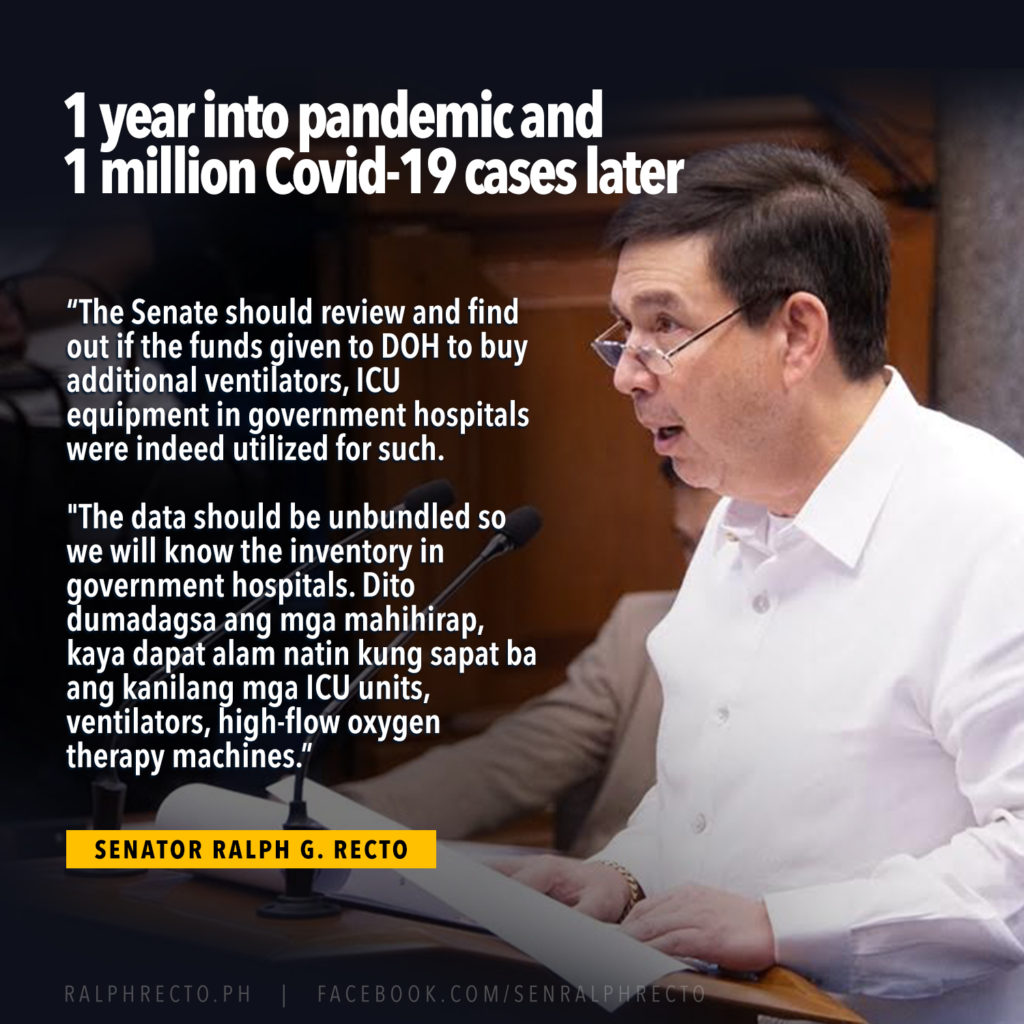1 year, 1M cases later, was the DOH able to buy enough ventilators, ICU units, high-flow oxygen machines?
One year and one million cases after the country’s first recorded COVID-19 case, a count on the number of ICU beds, ventilators and critical care equipment in government hospitals is in order, Senate President Pro Tempore Ralph Recto said.
“In any war, we should always look at the logistics. For the frontlines to keep on fighting, the supply lines must keep on running,” he said.
As the nation grapples with another surge which saw cases breach the one million-mark, the Senate should begin its “mandatory review” of Department of Health (DOH) spending to find out if funds meant “for ventilators, ICU equipment were indeed utilized.”
Recto made the call following press reports that the DOH bungled the acquisition of 200 ICU beds offered by an Austrian company late last year, an allegation the DOH has strongly denied.

He said the increase in the number of COVID-19 dedicated mechanical ventilators in private and public hospitals from 1,446 units in May 2020 to 2,601 units this month “does not seem to be commensurate with the need.”
“Isa pa, hindi natin alam kung ilan ang ambag ng government hospitals. May nagsabi na karamihan ay alokasyon ng mga pribadong ospital,” Recto said.
“The data should be unbundled so we will know the inventory in government hospitals. Dito dumadagsa ang mga mahihirap, kaya dapat alam natin kung sapat ba ang kanilang mga ICU units, ventilators, high-flow oxygen therapy machines,” he said.
The latest daily report by the DOH also showed a nationwide total of 2,521 ICU units allocated for COVID-19 patients.
“Again, pinaghalong government and private ito. Pero ang mahalagang tanong, sapat ba ito?” Recto said.
“When public hospitals start posting ‘No admission for COVID patients’ signs, then we know the answer,” Recto said.
Recto said the DOH’s capital outlays (CO) budget, or funds for equipment and buildings, for 2019 and 2020 was P29 billion.
For this year, P14.7 billion was appropriated by Congress, bringing the three-year CO total of the DOH to P43.7 billion.
Not included are allocations of the four Quezon City-based hospitals which are classified as government corporations and whose annual operating budgets are not included in the Department of Health’s.
“Hindi pa kasama dito ang mga augmentations at realignments na pinahintulutan ng Bayanihan Act I and II,” Recto said.
“For example, part of the DOH’s P35.51 billion share from Bayanihan II authorized expenses is the procurement of P3 billion worth of PPEs. Also included is P4.5 billion for the construction of temporary medical isolation facilities and field hospitals,” Recto said.
In its latest report, the DOH said there are 10,788 beds in wards for COVID-19 patients, from 1,751 in May 2020. The number of isolation beds also rose from 4,999 in May 2020 to 19,572 this month.
“Again, in the case of wards, we have to identify where these are. Our interest is knowing if the DOH has been able to mount a build-up of resources over the past 13 months,” Recto said.

